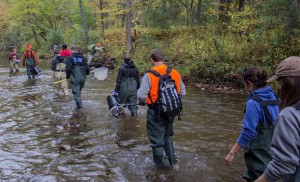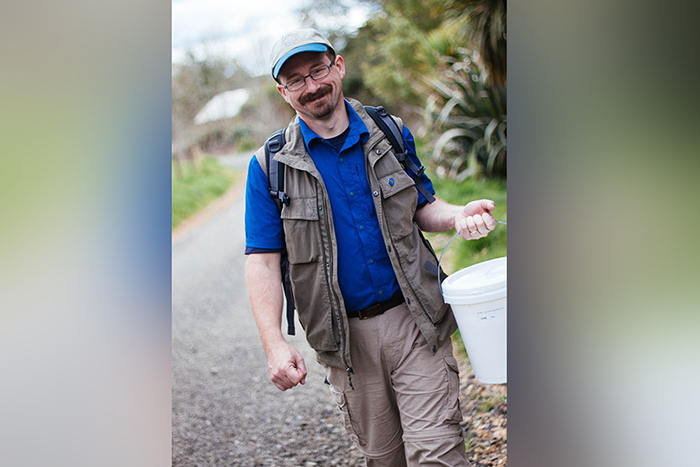Wading through ice cold water, catching turtles and examining stream insects may not seem like a typical summer. For Eastern Mennonite University (EMU) biology professor Jim Yoder, these activities are part of his work toward the restoration of the Chesapeake watershed.
Beginning in 2013, Yoder teamed with fellow biology professor Doug Graber-Neufeld to formulate a project that would combine their interests of ecology and water monitoring and involve students.
The multidisciplinary project — funded by the National Fish and Wildlife Foundation’s Chesapeake Bay Stewardship Fund, among other sponsors— will be the subject of the first Suter Science Seminar of the 2015-16 academic year. Yoder will speak about conservation and restoration efforts Wednesday, Sept. 14 at 4 p.m. in Suter Science Center 104.
Multiple partners contribute
He and Graber-Neufeld are also partnering with a Smithsonian Conservation Biology Institute researcher, a scientist from Ecosystem Services, LLC, and EMU’s Center for Justice and Peacebuilding (CJP). CJP is involved in the sociological aspects of the project which connect conservation efforts with the community.
Graber-Nuefeld and Yoder selected Bergton, Virginia as the research site because of the degraded streams and also because of existing relationship between area residents and EMU students and professors. The community has previously been a part of water monitoring efforts as well.
Tackling such an endeavor is not without its challenges. This has been the largest project. Yoder has been involved in since he’s been at EMU. “Coordinating the many variables, such as field work, travel distances, weather that doesn’t cooperate, and liaising between a large number of students, multiple departments here at EMU, the Smithsonian, and three to four other public and nonprofit agencies has been extremely challenging,” he said.

Getting to know the people of Bergton has been a highlight for Yoder. “I’ve also enjoyed being in the community and developing relationships with local residents, who are wonderful,” Yoder says. Some of his favorite parts of the project include tagging and releasing wood turtles and engaging with students during field work.
Childhood alongside a stream motivates student worker
For one student among the 20 who have assisted Yoder over the years, working with the stream has been especially meaningful. Aubrey Shelly, a junior biology and environmental sustainability major, worked with Yoder this summer collecting water samples and identifying the macro-invertebrates found in the streams.
Shelly says her interest in conservation efforts mostly stems from childhood encounters with a stream in her neighborhood. “Growing up, my weekends always included bike trips down to the local stream with my dad,” she said. “We would look for turtles, catch crayfish, and appreciate the change of pace that the body of water provided from our suburban setting.”
When thinking about how these conservation efforts will have a positive effect on Bergton residents and the Chesapeake Bay watershed, Shelly says, “as well as promoting an increase in community awareness of stream restoration issues, this project has the potential to mitigate flooding of residential areas and create an overall healthier system of agriculture within farm and grazing areas.”
Student researcher Curtis Martin, a former Bergton resident, looks forward to the long-term impact of Yoder’s work. “One goal of this project is to reduce the amount/intensity of flooding by creating a better floodplain.” He goes on to explain a functional floodplain will slow erosion and keep environmental damage at bay.
Reducing the damage done by flooding could help to restore species to the river that will enrich the community’s water. “Increased biodiversity and ecosystem habitat will hopefully lead to more opportunities for recreational fishing,” said Martin, who plans a career in the field and has gained a professional network from his participation in the project.
